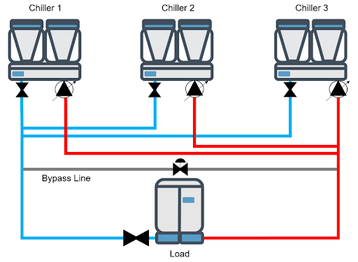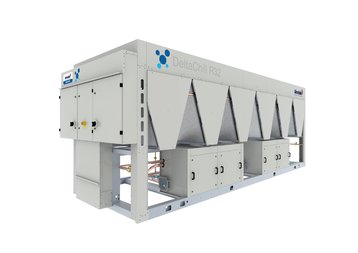As new technologies for cooling data centers enter the industry, the temptation is to disregard more tried and tested methods, making the assumption that ‘new technology’ must somehow automatically equate to ‘better technology,’ but this isn’t always the case.
As with any new tech, it is really important to not only understand what it offers, but also consider if what you already have is actually broken, or if you might be being sold a problem you don’t actually have.
Furthermore, it is also crucial to consider if the application of the new tech meets your specific requirements. For example, some new methods are really effective in super high-density scenarios, but whilst impressive, it might be less effective in your specific setting.
As ever, knowledge is power. Whilst most new tech has its place, it might not be in your place, so understanding the claims and being able to cut through the noise will lead to an informed decision.
We know that some providers focus on the negatives of traditional methods as opposed to the positives of their own. Whilst most clients are savvy enough to recognise this as a sales technique, sometimes the data presented is convincing, especially when the supplier has perhaps used comparison data which is out of date, hoping that the data center professional isn’t conversant with legacy systems.
With energy efficiency and water use at the forefront of the data center conversation this year, it is an important time to correct some unsubstantiated claims, bust some myths and right some of the misconceptions around chilled water data center cooling systems.
Chilled water systems absolutely can remain the technology of choice to cool a new era of efficient, cost effective and sustainable digital infrastructure and here we will consider how.
Myth 1: You can’t build out chilled water systems easily or quickly
This is something we hear a lot. Things like “chilled water systems aren’t scalable” and “you can’t add or remove chillers while the system is live”.
Or, that they are difficult to install and set up and involve lots of componentry, or require large roof/plant room space, or simply the speed of deployment doesn’t work with the site.
All of these claims might have been true historically, or might be true now for some older style chillers, but it is so important to understand that this is not always the case.
Alternatives are available within chilled water systems that make them more adept/agile to their settings. For example, it is possible to include the hydraulic componentry within the chiller package.
Onboard pumps and waterside ancillaries are available, meaning the chillers become a quick deploy modular component and this leads to decreased build/installation times.
We have also seen installations employ a large low-loss header, positioned across the chiller compound, with tap-off points allowing the site to scale up as the facility’s load grows.
Alternatively, hydraulic componentry can be reduced by eliminating the low-loss header and feeding the cooling plant direct from the chiller, with the chiller pump sized to accommodate full flow at system losses.
All of these options are now available on many chilled water systems, but of course are disregarded because they don’t support the argument for the newer, different methods.
Myth 2: Too expensive to buy, install and operate
Most operators are keen to become as cost effective as possible and as such may disregard chilled water systems when they are fed the list of complementary systems and services required.
Often we hear that chilled water systems have been rejected because they need chillers, pumps, valves, pipework, buffer tanks, CRAHs and complex control systems. Actually, when fully costed, these plant costs are in line with other technologies.
It is true that some of the newer technologies may reduce electrical infrastructure costs, but this headline is often hiding the expense of substantially increased water usage, which is costly to both the client and our planet.
Continuing the theme of lifecycle costs, plant costs are generally less than other technologies as new technologies and materials are helping to keep capital cost down, whilst increasing efficiency to take advantage of much lower operating costs.
For example, increasing the water-side temperature difference (Delta T) to reduce pipe sizing, saving cost on not only pipework but valves and pumps. Likewise, single pump cooling loops negate the need for secondary circulating loops and low loss headers.
Increasing the indoor heat exchanger capacity (by improving air flow through the unit and increasing coil surface area), allows flow temperatures to increase, reducing chiller capacity and therefore associated cost. Without the requirement for water treatment, storage and legionella risk, chillers are reasonable on the running costs.
Conversely, in other systems requiring the use of cooling towers, there are onerous maintenance schedules that negatively impact OPEX costs. By the nature of the beast, direct air systems are always likely to need a lot more maintenance due to the increased risk of contamination.
Myth 3: Chilled Water can’t compete with the PUEs of adiabatic systems
Efficiency is high on the agenda of any self-respecting data center professional, for both cost and environmental reasons, and this draws in the long-standing debate about PUEs.
Forgetting for a moment its effectiveness as a metric, generally speaking there seems to be an understanding that low PUEs can only be achieved with adiabatic systems and that chiller-based systems can’t compete on this metric.
We often hear concerns about chillers not being able to deliver 100 percent free cooling and having to rely on mechanical cooling at high ambient, with the compressors working hard for much of the operational life. Another myth is that chillers are not set up for latest trends i.e. higher fluid operating temperatures.
Again, most of this is outdated nonsense. Firstly, if PUEs are the measurement to work with, it is so important to know that many modern economized free cooling chiller systems can be designed to 1.2 to 1.3 PUE. The clue of course there is in the name: modern. These latest chillers are now designed for higher fluid temperatures and have fully optimised energy management using smart control systems.
As a further food for thought, we also come back to water usage and question if PUE is the most appropriate metric to consider. With many of the bigger data centers now taking water usage costs seriously, they are opting to work with WUE as an efficiency performance target.
It is absolutely true that we cannot underestimate the danger to our entire existence, both as an industry, and a planet, if we do not elevate the consideration of water wastage into our operational decisions.
Myth 4: All data centers will be cooled by liquid immersion in the future
Whenever anyone makes such grand sweeping statements, I would always advise caution. Liquid immersion is a new technology that again, will have some benefits in some applications, but the suggestion of a one-size-fits-all approach is laden with complacency.
The argument we most frequently hear is that liquid cooling caters for the high density racks we are surely all heading towards. However, very few data centers require high density racks. The majority of racks are still below 5kW (and will remain so for the foreseeable future) and therefore this would be overkill for their requirements.
Another argument is that immersion cooling saves valuable floor space and with less moving components involved, is less maintenance intensive. However, access to equipment and concerns over contaminants will need to be fully addressed before employing this technology.
As a supplier of chilled water systems that can operate in tandem with other technologies, and in an industry that is seeing data centers operate different density racks within the same site, what we suggest is that the future of data center cooling will see a combination of technologies employed, to best serve the client, not the cooling provider!
Myth 5: Chillers are fine in free cooling conditions, peak power is what kills them
Those that support competing technologies may be heard suggesting that free cooling chillers are only efficient at certain temperatures, and have to rely heavily on less efficient mechanical cooling at higher ambient temperatures, leading to a reduction in chiller efficiency as the operating ambient rises.
The truth is that technological advancements mean that Airedale can offer a low-cost option to reduce peak power on hottest ambient days. Pre-cooling adiabatic systems can be a cheap and water-efficient way to take the top few degrees away to mitigate peak ambient load, and we can drop compressor sizes if we don’t need to work at peak dry bulb ambient.
So what we have is a smaller chiller, with a pre-cooling adiabatic system fitted to it, where the adiabatic just serves to take the top few degrees down. This system offers low water usage compared to towers and adiabatic all-air systems.
Myth 6: Difficult to manage water systems
Contrary to some opinion, chilled water systems are not difficult to manage. Often cited as complex because they require intricate control systems and algorithms to manage pressures, flow and temperature rates and the associated physical components to enable these, the reality is that the sophisticated engineering employed allows for controls and sequencing of multiple units, whilst offering variable set point and flow management.
Our chillers are engineered with a fast start after power failures (typically 3 to 3.5 min to full load) and this fast start sits within the individual chillers, so the chiller has total control over flow without relying on an external BMS.
We also offer chiller variable flow – a technology that is imperative in the future of chilled water data center cooling. Crucially, our systems are designed to be failsafe and to revert to standalone control in the event of a system failure.
Overall system control offers lots of advantages to the end user, including significant energy savings and enhancements to redundancy using smart control monitoring systems. As the industry moves towards embracing AI, we get added benefits of dynamic control and can do predictive maintenance, which really helps to reduce costs and increase reliability.
Myth 7: Chillers are inflexible
This is one of those old-adages that perhaps was true a few years ago, but in line with technological advancements, no longer holds any water.
Perhaps just three years ago, chiller operating limits and efficiencies were preventing the industry achieving the PUEs it strove for and this is what allowed alternatives, such as adiabatic dry air coolers, to move in on this market. However, that is old news.
Supply water temperatures have increased in line with evolving standards and working with bodies such as ASHRAE, developing systems for aisle containment and working more closely with original equipment manufacturers, has all led to increased operational temperatures.
Piped systems offer better flexibility; as new liquid cooled solutions become more prevalent, they can be easily deployed within the same air side chilled environment. The way to do it is with effective arrangement of cooling loads in a structured series, with the supply water fed through CRAHs first and then through secondary cooling ancillaries to feed the liquid cooled racks.
The chillers need to be designed to operate at a much wider temperature difference, typically 28 to 29oF, with maybe the first 14 oF taken up by CRAH units, and the next 14 oF is the temperature drop across the liquid cooling. This works to increase the efficiency of the plant whilst reducing pipe sizing and pressure drop.
Furthermore, chillers have seen significant componentry improvements in recent years. Low GWP refrigerants provide environmental as well as performance benefits, and advanced evaporator technology enables us to deliver close approach temperatures.
Improved condenser and free cooling coils, increased efficiency fans, electronic expansion valves, improved compressors, and significant improvements in controls have all benefited from improvements in efficiencies and performance which has lead to benefits for the end-user:
- Closing the approach temperature increases the efficiency of the heat exchange between water and air.
- Lower approach means higher supply water temperatures.
- Widening the Delta T increases the efficiency of the chiller and reduces pump power.
- Wider Delta T means more free cooling (including partial free cooling).
- Wider Delta T means smaller external heat rejection hardware.
Without doubt, this optimization of air and water has brought the chiller back as today’s preferred technology for data center cooling.
Myth 8: You can’t achieve net zero with chilled water
As the pressure to be more sustainable grows, data center operators are often bombarded with information and misinformation about what will work with their business to achieve the ever important net zero status.
Sometimes within that conversation, chilled water systems get thrown under the bus because of their use of mechanical cooling. Also cited as a reason to avoid chillers, as mentioned before, is the high power draw during peak ambient conditions and of course the volume of refrigerant to deal with.
Again, we cannot stress enough that chiller technology has also advanced enabling the following sustainable options within the system:
- High fluid operating temperatures.
- Closer economizer approach temperatures (based on 5R coil re-engineered option).
- Wider fluid side temperature differentials (driven by heat exchanger technologies employed on the internal cooling plant).
- Chiller variable flow.
- Compressor efficiency improvements.
- Fans Gen II EC type operational improvements.
- Low GWP refrigerant options available.
When using adiabatics, it is important to consider the carbon factor of water use. Five percent of all carbon emissions are linked to water usage so we have to try to eliminate water as much as we can.
Of course, all cooling systems have power draw, so we really need to consider the source of the power and carbon offsetting where necessary. As we move to renewables, this problem should reduce, but there will always be a certain amount of carbon produced and we are tasked with reducing this as much as we can.
In summary
Chilled water systems are evolving to meet the efficiency and sustainability objectives demanded by the data center industry today. With sustainability high on the agenda, it is crucial we drive down water and energy use, whilst operating at higher temperatures and chilled water systems can do this, and will work effectively alongside other cooling technologies where required, to deliver efficient cooling solutions.
Crucially, the end user needs to be informed and able to select the solution that meets the demands of their business, not the needs of the solution provider. 24/7 efficient and sustainable cooling that meets the demands of society and business today is what we are all working to achieve for our clients, and we are confident that chilled water systems can do this and will remain the technology of choice.



